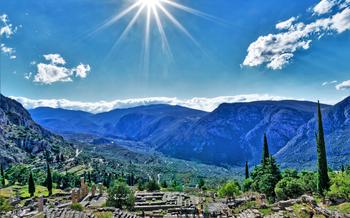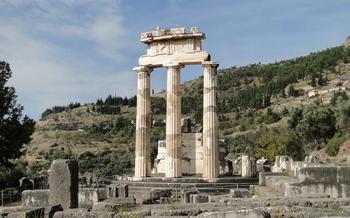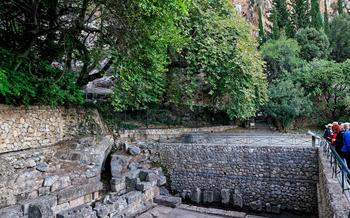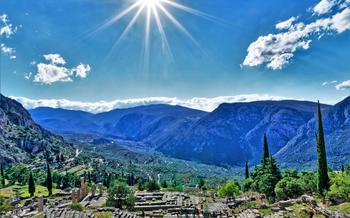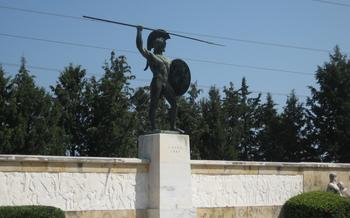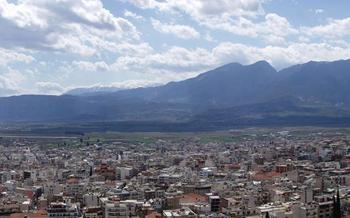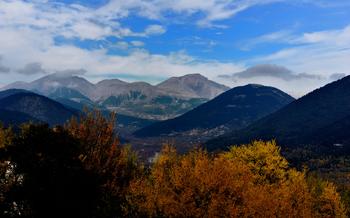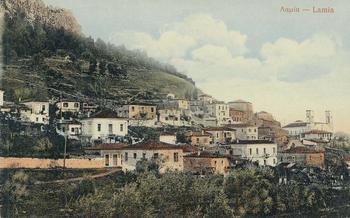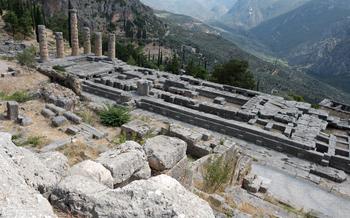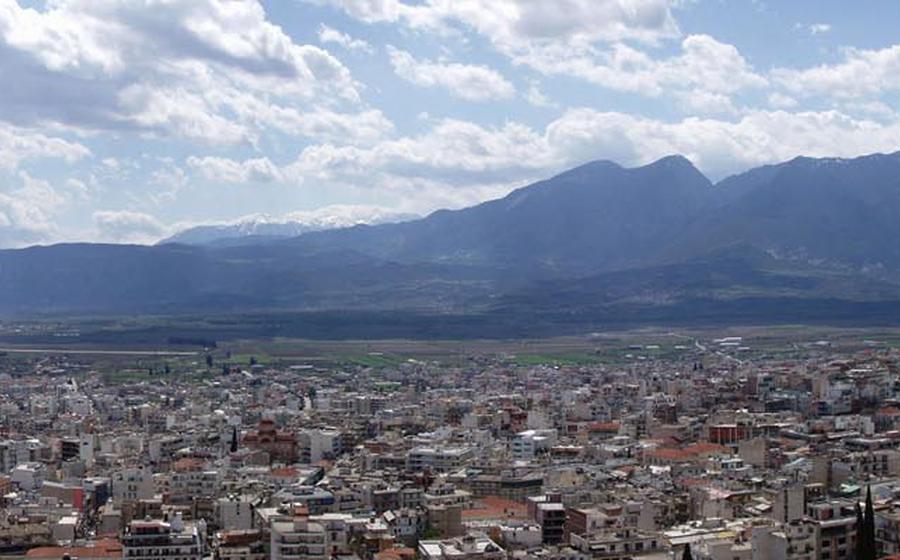
Thermopylae Monument and Historical Site
- Thermopylae Monument and Historical Site: A Legacy of Valor and Sacrifice
- Leonidas I: The Legendary Spartan King
- The Persian Army: A Mighty Force
- The Battle of Thermopylae: A Turning Point in History
- The Thermopylae Pass: A Strategic Gateway
- Geographical Importance
- Control and Contention
- Natural Features and Terrain
- The Legacy of Thermopylae
- Exploring the Historical Site
- The Battle Museum of Thermopylae: Unveiling the Past
- The Annual Thermopylae Festival: Honoring the Past with Cultural Festivities
- Nearby Attractions and Points of Interest
- Accommodation and Dining Options
- Tips for Visitors
- The Legacy of Thermopylae in Modern Times
- Sustainable Tourism Practices
- Insider Tip: Unveiling the Hidden Gem of Thermopylae
Thermopylae Monument and Historical Site: A Legacy of Valor and Sacrifice
The Thermopylae Monument and Historical Site stand as a testament to the epic battle that took place in 480 BC, where a small force of 300 Spartans and their allies fought valiantly against the mighty Persian army. This heroic stand, despite the overwhelming odds, has left an enduring legacy of valor and sacrifice that continues to inspire generations.
The monument, situated in the narrow pass of Thermopylae in central Greece, marks the site of the legendary battle. It features a majestic bronze statue of Leonidas I, the Spartan king who led the defense against the Persian invasion. The statue, towering over the surrounding landscape, symbolizes the indomitable spirit of the Spartans and their unwavering commitment to freedom.
The historical site, encompassing the monument and the surrounding area, offers visitors a glimpse into the events that transpired during the battle. Informative plaques and displays provide detailed accounts of the conflict, highlighting the strategies, tactics, and heroic deeds of the Spartan warriors.
Visitors can explore the battlefield, immersing themselves in the atmosphere of this pivotal moment in ancient history. The site's evocative scenery, with its rugged mountains and narrow pass, transports visitors back in time, allowing them to appreciate the daunting challenges faced by the Spartan and allied forces.
The Thermopylae Monument and Historical Site serve as a poignant reminder of the sacrifices made by a small band of warriors who stood their ground against an overwhelming force. Their legacy of valor and selflessness continues to resonate, inspiring awe and admiration in all who visit this hallowed ground.
Leonidas I: The Legendary Spartan King
Leonidas I, the revered king of Sparta, emerged as a legendary figure due to his exceptional leadership and military prowess. His name became synonymous with courage, honor, and unwavering devotion to duty. Leonidas's reputation as a skilled commander and strategist preceded him, inspiring awe and respect among both allies and adversaries.
His unwavering commitment to defending his homeland against the formidable Persian army cemented his legacy as a symbol of Spartan valor. Leonidas meticulously prepared his forces, comprising 300 elite Spartan warriors and approximately 7,000 Greek allies, for the impending clash at Thermopylae.
Leonidas's strategic brilliance shone through as he positioned his troops within the narrow pass, maximizing the defensive advantage of the terrain. He employed innovative tactics, including the formation of a shield wall, to repel the seemingly unstoppable Persian onslaught.
Despite the overwhelming odds, Leonidas and his valiant warriors fought with indomitable spirit, inflicting significant casualties on the Persian army. Their heroic stand, though ultimately resulting in their demise, served as a pivotal moment in the Greco-Persian Wars, inspiring the Greek city-states to unite against the Persian threat.
Leonidas's legacy transcended the boundaries of time, cementing his status as an iconic figure of courage, selflessness, and unwavering dedication to the ideals of freedom and independence. His name continues to resonate throughout history, serving as a timeless reminder of the power of human spirit and the enduring impact of heroic sacrifice.
The Persian Army: A Mighty Force
The Persian army that marched against Greece in 480 BC was a formidable force, both in terms of size and composition. The army was led by King Xerxes I, who had inherited the throne from his father, Darius I, who had failed to conquer Greece a decade earlier. Xerxes was determined to succeed where his father had failed, and he assembled an army that was far larger than anything the Greeks had ever seen before.
The Persian army was made up of a variety of units from across the vast Persian Empire. There were infantrymen from Persia itself, as well as from the satrapies of Asia Minor, Syria, Phoenicia, Egypt, and Babylonia. There were also cavalrymen from Media, Scythia, and Thrace. In addition, there was a large contingent of Greek mercenaries from Ionia and Aeolis, who had been recruited by the Persians to help them fight against their fellow Greeks.
The Persian army was also well-organized and disciplined. The army was divided into units of 10,000 men, each of which was commanded by a satrap. The satraps were in turn responsible to the king, who was the supreme commander of the army.
The Persian army was also well-equipped. The infantrymen were armed with bows and arrows, spears, and short swords. The cavalrymen were armed with lances and javelins. The army also had a number of siege engines, including battering rams, catapults, and siege towers.
The Persian army was a powerful force, and it was confident of victory. However, the Greeks were determined to defend their homeland, and they were led by some of the greatest generals in history. The Battle of Thermopylae would be a test of strength and courage, and it would ultimately decide the fate of Greece.
The Battle of Thermopylae: A Turning Point in History
The Battle of Thermopylae unfolded over three grueling days, each marked by intense fighting and unwavering resolve. On the first day, the Persian army, despite its overwhelming numbers, struggled to break through the Spartan defenses. The Spartans, with their superior discipline and tactical prowess, held their ground, repelling wave after wave of Persian attacks.
On the second day, the Persians attempted to outflank the Spartans by sending a detachment of troops through a mountain pass. However, the Spartans, having anticipated this move, were ready and waiting. The detachment was ambushed and annihilated, demonstrating the Spartans' strategic acumen and their ability to adapt to changing circumstances.
The third and final day of the battle was the most desperate. The Persians, enraged by their losses, launched a massive assault on the Spartan positions. The Spartans, outnumbered and exhausted, fought valiantly but were eventually overwhelmed. Leonidas and his 300 Spartans fell, along with many of their allies.
Despite their defeat, the Spartans' heroic stand at Thermopylae had a profound impact on the course of history. It demonstrated to the Greeks that even against overwhelming odds, courage and determination could prevail. The battle inspired the Greek city-states to unite and resist the Persian invasion, leading to a series of decisive victories that ultimately turned the tide of the war and saved Greece from conquest.
The Thermopylae Pass: A Strategic Gateway
The Thermopylae Pass, where the epic battle took place, holds immense strategic significance due to its geographical features. Situated between the Malian Gulf and the Kallidromos Mountains, the pass forms a narrow corridor, making it a crucial gateway between Central Greece and Thessaly. The pass is flanked by steep cliffs on one side and the sea on the other, creating a natural chokepoint that has been contested and controlled by various empires throughout history.
Geographical Importance
The Thermopylae Pass has always been a vital land route for armies marching between northern and southern Greece. Its strategic importance was recognized as early as the 6th century BC, when the Thessalians constructed a wall across the pass to defend against Persian incursions. The narrow passage allowed a small force to hold off a much larger army, making it an ideal defensive position.
Control and Contention
The Thermopylae Pass has been the site of numerous battles and conflicts throughout history. In ancient times, it was fought over by the Greeks, Persians, Macedonians, and Romans. In more recent centuries, it was contested by the Byzantine Empire, the Ottoman Turks, and the modern Greek state. The strategic value of the pass has ensured that it has been a focal point of military campaigns and territorial disputes for centuries.
Natural Features and Terrain
The Thermopylae Pass is a narrow strip of land, approximately 5 kilometers wide at its widest point. It is surrounded by the Malian Gulf to the east and the Kallidromos Mountains to the west. The pass is dominated by a series of hot springs, which were considered sacred in ancient times and gave the pass its name (Thermopylae means "hot gates" in Greek).
The Legacy of Thermopylae
The Thermopylae Pass continues to hold strategic importance in modern times. It is a major transportation route, with the national highway and railway line passing through the pass. The legacy of the ancient battles fought here ensures that the Thermopylae Pass remains a place of historical and cultural significance, attracting visitors from around the world who come to pay homage to the heroes who fought and died in this narrow defile.
Exploring the Historical Site
The Thermopylae Historical Site is a treasure trove of ancient ruins, monuments, and artifacts that bring the legendary battle to life. Visitors can immerse themselves in the history and significance of this pivotal event through various attractions and interactive exhibits.
At the heart of the site stands the majestic Leonidas Statue, a towering tribute to the Spartan king who led the heroic stand against the Persian army. The statue captures Leonidas's unwavering determination and courage, inspiring awe and admiration in visitors.
The Hot Springs, naturally occurring thermal springs believed to have been used by ancient soldiers to bathe and heal their wounds, offer a unique glimpse into the daily lives of the warriors who fought at Thermopylae. These springs continue to flow today, adding an element of natural beauty to the historical site.
Archaeological excavations have uncovered Ancient Ruins and Artifacts that shed light on the battle's aftermath. Visitors can explore the remains of fortifications, weaponry, and personal belongings, gaining a deeper understanding of the Spartan's resilience and the challenges they faced.
Interactive Exhibits and Displays enhance the visitor experience by providing detailed information about the battle's chronology, strategies, and outcomes. These exhibits use multimedia presentations, touchscreens, and interactive maps to engage visitors of all ages and make the history of Thermopylae come alive.
The Battle Museum of Thermopylae: Unveiling the Past
Located at the Thermopylae Historical Site, the Battle Museum of Thermopylae offers visitors an immersive and educational journey into the events of the legendary battle. Through its captivating exhibits and interactive displays, the museum brings to life the story of the brave Spartan warriors and their heroic stand against the mighty Persian army.
Collections and Exhibits: The museum showcases an array of artifacts unearthed from the battle site, including weapons, armor, and pottery fragments. These relics provide tangible evidence of the fierce struggle that took place in 480 BC. Additionally, detailed exhibits present historical context and information, allowing visitors to gain a deeper understanding of the battle's significance.
Interactive Elements: The museum incorporates engaging interactive elements to enhance the visitor experience. Touchscreen displays offer in-depth information about the battle's timeline, strategies, and key figures. Virtual reality simulations transport visitors to the battlefield, providing a visceral sense of the conflict's intensity.
Historical Context and Interpretation: The museum's exhibits are carefully curated to provide historical context and interpretation. Visitors can explore maps, timelines, and diagrams that illustrate the battle's strategic importance and the broader context of the Greco-Persian Wars. Expert commentary and historical analysis shed light on the motivations, decisions, and consequences that shaped this pivotal event.
Educational Programs and Activities: The Battle Museum of Thermopylae offers a range of educational programs and activities to cater to visitors of all ages. Workshops, lectures, and guided tours provide opportunities for deeper engagement with the museum's collections and historical content. School groups and students can participate in interactive learning experiences designed to foster critical thinking, historical empathy, and a deeper understanding of ancient Greece.
The Annual Thermopylae Festival: Honoring the Past with Cultural Festivities
The legacy of Thermopylae is not only preserved through historical sites and museums but also through vibrant cultural events. The annual Thermopylae Festival is a celebration that brings the past to life, honoring the memory of the brave Spartans and their heroic stand.
During the festival, the town of Lamia transforms into a stage of history and tradition. The streets are adorned with decorations inspired by ancient Greece, and the air is filled with the sounds of traditional music and performances. Visitors can immerse themselves in the rich history of the region and experience the vibrant spirit of Greek culture.
Historical reenactments are a highlight of the festival. Talented actors and performers recreate the epic battle scenes, bringing to life the valor and sacrifice of the Spartans. These reenactments offer a unique opportunity to witness the events of Thermopylae as they might have unfolded centuries ago.
The festival also features traditional Greek cuisine, allowing visitors to savor the flavors and culinary traditions of the region. Local tavernas and restaurants offer a variety of dishes, from mouthwatering grilled meats to fresh seafood and delicious pastries.
Cultural performances, such as music, dance, and theatrical productions, add to the festive atmosphere. These performances draw inspiration from Greek history and mythology, showcasing the rich cultural heritage of the region.
The Thermopylae Festival is not merely a celebration of the past but also an opportunity for visitors to connect with the present-day culture and traditions of Greece. It is a vibrant and immersive experience that leaves a lasting impression on all who attend.
Nearby Attractions and Points of Interest
In addition to the Thermopylae Monument and Historical Site, the region offers a wealth of other attractions that provide a glimpse into Greece's rich history and diverse natural landscapes.
-
Ancient Delphi: Just a short drive from Thermopylae, the ancient city of Delphi awaits exploration. Home to the renowned Oracle of Delphi, this UNESCO World Heritage Site features well-preserved ruins, including the Temple of Apollo, the Delphi Museum, and the Castalian Spring.
-
Meteora Monasteries: Perched atop towering rock formations, the Meteora Monasteries offer a breathtaking sight. These architectural marvels, dating back to the 14th century, provide a glimpse into the region's monastic history and offer stunning panoramic views.
-
Mount Parnassus: For those seeking outdoor adventures, Mount Parnassus beckons with its scenic trails and picturesque landscapes. Hike through lush forests, admire cascading waterfalls, and enjoy breathtaking views from the mountain's peak.
-
Traditional Greek Villages: Immerse yourself in the authentic charm of traditional Greek villages nestled amidst the region's countryside. Explore narrow cobblestone streets, visit local markets, and savor delicious homemade dishes in charming tavernas.
Accommodation and Dining Options
When planning your visit to Thermopylae, you'll find a range of accommodation options to suit your needs and budget. From cozy guesthouses to modern hotels, there are plenty of places to stay near the historical site.
For a truly immersive experience, consider staying in one of the traditional Greek villages surrounding Thermopylae. These charming villages offer a glimpse into local life and culture, with friendly locals and authentic accommodations.
When it comes to dining, Thermopylae and the surrounding area offer a variety of culinary delights. Traditional Greek restaurants serve up mouthwatering dishes using fresh, local ingredients. Savory grilled meats, seafood specialties, and delicious homemade pastries are just a few of the culinary treats you can expect.
Don't miss the opportunity to visit local cafes and tavernas, where you can relax with a refreshing drink or indulge in traditional Greek coffee. These charming establishments offer a warm and welcoming atmosphere, perfect for soaking up the local vibes.
For those looking to sample regional specialties, be sure to try the local cheeses, olives, and honey. These products are renowned for their exquisite flavors and are a testament to the rich culinary traditions of the region.
Tips for Visitors
When planning your visit to Thermopylae, consider the following tips to make the most of your experience:
-
Best Time to Visit: The ideal time to visit Thermopylae is during spring (April-May) or autumn (September-October) when the weather is pleasant, and the crowds are smaller.
-
Dress Code and Cultural Etiquette: Respect local customs by dressing modestly and behaving respectfully. Avoid loud noises and disruptive behavior at historical sites.
-
Photography and Videography: While photography is generally allowed, respect any restrictions or guidelines posted at specific locations. Use discretion when taking photos of people, especially during religious ceremonies or traditional events.
-
Guided Tours and Local Guides: Enhance your visit with a guided tour led by a knowledgeable local guide. They can provide insights into the history, culture, and significance of Thermopylae.
The Legacy of Thermopylae in Modern Times
The legacy of the Battle of Thermopylae extends far beyond the ancient world. The battle has been immortalized in literature, film, and art, inspiring generations with its themes of heroism, sacrifice, and the indomitable spirit of the human will.
In modern times, Thermopylae continues to be a source of fascination and inspiration. It has been the subject of numerous books, articles, and documentaries, and has been depicted in popular culture through films such as "300" and "The 300 Spartans." The battle's enduring significance is also reflected in the many commemorative events and anniversaries that are held each year to honor the memory of the Spartans and their heroic stand.
Beyond its historical and cultural significance, Thermopylae has also become a powerful symbol of courage, resilience, and the triumph of the human spirit over adversity. The battle's legacy serves as a reminder that even in the face of overwhelming odds, it is possible to achieve greatness and leave an indelible mark on history.
Sustainable Tourism Practices
As a visitor to the Thermopylae Monument and Historical Site, it is essential to embrace sustainable tourism practices that minimize your environmental impact and support the local community. Start by choosing eco-friendly accommodation options that prioritize energy efficiency and water conservation. Opt for locally-owned hotels and guesthouses that actively engage in sustainable practices.
When dining, seek out traditional Greek restaurants that use fresh, locally sourced ingredients. This helps support local farmers and producers while reducing the carbon footprint associated with food transportation. Similarly, visit local markets and shops to purchase souvenirs and handicrafts directly from artisans, contributing to the local economy.
Respect the historical significance of the site by following designated trails and pathways, avoiding any damage to the ancient ruins or artifacts. Dispose of waste responsibly, using designated bins and recycling facilities. By practicing sustainable tourism, you not only preserve the beauty and integrity of Thermopylae but also contribute to the well-being of the local community.
Insider Tip: Unveiling the Hidden Gem of Thermopylae
Beyond the iconic Thermopylae Monument and Historical Site, Lamia holds another hidden gem worth exploring: the Ancient Theater of Lamia. Nestled amidst scenic surroundings, this lesser-known archaeological site offers a fascinating glimpse into the region's rich past. The theater dates back to the 3rd century BC and was a prominent cultural center in ancient Greece, hosting theatrical performances, musical events, and civic gatherings.
Although smaller in scale compared to other ancient theaters in Greece, the Ancient Theater of Lamia exudes a unique charm and historical significance. Its well-preserved stone seating rows provide a glimpse into the architectural prowess of the ancient Greeks. The theater's acoustics are remarkable, allowing visitors to experience the same auditory clarity enjoyed by audiences centuries ago.
To fully immerse yourself in the local culture, time your visit to coincide with one of the many festivals and events held in Lamia throughout the year. These celebrations showcase the region's vibrant traditions, offering visitors a chance to savor delicious local cuisine, witness traditional dances, and engage with the warm hospitality of the Greek people.
Whether you're a history buff, a theater enthusiast, or simply seeking an off-the-beaten-path experience, the Ancient Theater of Lamia is a hidden gem that should not be missed. Its historical significance, combined with the charm of Lamia's local culture, makes for an unforgettable and enriching travel experience.
